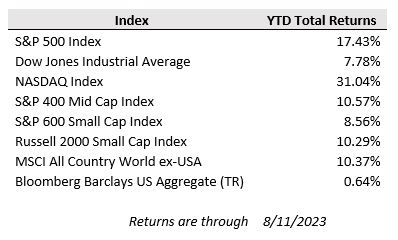After a strong rally to start the year, markets have given back a bit in August thus far, with the S&P 500 down around 3% since its recent high on July 31, the Nasdaq down over 4.0% during this period, and the "Magnificent 7" large-cap stocks are down over 5.0%. The parts of the market that have led the way higher are now perhaps catching their breath, which may be viewed as a healthy pullback as investors digest large gains. Equity markets remain strongly positive year to date.
Last week started out on a rocky note as Moody’s downgraded the credit ratings of several small-to mid-sized banks and said it may lower the ratings on six major banks, including US Bancorp, State Street, and Bank of New York Mellon. Moody’s cited the outlook as the banking sector “continues to contend with interest rate and asset and liability management risks with implications for liquidity and capital.”
The Consumer Price Index for All Urban Consumers (CPI-U) rose 0.2% in July on a seasonally adjusted basis, the same increase as in June, the U.S. Bureau of Labor Statistics reported. Over the last 12 months, the all items index increased 3.2% before seasonal adjustment. The all items less food and energy index rose 4.7% over the last 12 months. The energy index decreased 12.5% for the 12 months ending July, and the food index increased 4.9% over the last year. The data were in line with expectations, boosting hopes for a soft landing and reinforcing market expectations the Fed has reached its terminal rate.
Meanwhile producer prices came in slightly hotter than expected, but most of the upside surprise was driven by an uptick in energy prices compared to a year ago. The Producer Price Index increased 0.3% in July from the previous month, the Labor Department reported. The index, which measures price changes on products and services before they reach consumers, showed prices increased 0.8% in July from a year before. Prices for final demand less foods, energy and trade services increased 2.7% from a year before. Overall, cooling core PPI readings suggest that further consumer goods disinflation is in store in the months ahead, a welcome development to consumers and the Federal Reserve.
Looking overseas, economic activity in China continues to surprise to the downside as China’s trade fell much faster than expected in July. Data showed the country’s exports fell 14.5% for the year to July, the largest decline since the COVID outbreak, while imports slid 12.4%, worse than forecast.
The week ahead will give some important insights on the health of the U.S. consumer as some of the largest retailers in the S&P 500 report this week, including Walmart, Home Depot, Target and TJX Companies. Applied Materials and Cisco, two tech giants, are also scheduled to report earnings this week.


